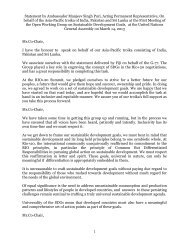STATE OF THE WORLD'S CITIES 2012/2013 Prosperity
STATE OF THE WORLD'S CITIES 2012/2013 Prosperity
STATE OF THE WORLD'S CITIES 2012/2013 Prosperity
Create successful ePaper yourself
Turn your PDF publications into a flip-book with our unique Google optimized e-Paper software.
State of the World’s Cities <strong>2012</strong>/<strong>2013</strong><br />
RE-POSITIONING URBAN PLANNING AT <strong>THE</strong><br />
HUB <strong>OF</strong> <strong>THE</strong> WHEEL <strong>OF</strong> PROSPERITy<br />
“The city has many scars to treat and many wounds to cure;<br />
urban planning is powerless to do that” 38 , claims an expert in<br />
Santo Domingo (Dominican Republic). Still, in the 50 cities<br />
surveyed by UN-Habitat in 2011, efficient urban planning<br />
and urban management are perceived as the most important<br />
conditions for shared<br />
POLICy<br />
If urban planning<br />
is to be in a<br />
better position to address<br />
the shortcomings of the<br />
GS20C model, both theory<br />
and practice must come<br />
under serious review to<br />
‘rescue’ the discipline from<br />
its role as a mere technical<br />
tool, restoring it to its<br />
rightful position in the public<br />
sphere.<br />
POLICy<br />
As a decisionmaking<br />
tool<br />
urban planning must better<br />
defend the ‘public’ against<br />
the menace of everexpanding<br />
‘private’ interests<br />
and its consequences:<br />
shrinking public spaces<br />
and reduced provision of<br />
public goods, which affect<br />
more collective, intangible<br />
dimensions like quality<br />
of life, social interaction,<br />
cultural identity and social<br />
values.<br />
FACT<br />
Very often<br />
planning has<br />
failed to represent correctly<br />
collective values and<br />
agreements, instead<br />
of contributing to the<br />
perpetuation of the urban<br />
divide with daunting,<br />
outdated, irrelevant<br />
requirements.<br />
prosperity. 39<br />
For any revival or<br />
reinvigoration of urban<br />
planning to take place<br />
in the pursuit of shared<br />
prosperity, four conditions<br />
must be met: (i) restoration<br />
of public confidence; (ii)<br />
repositioning of urban<br />
planning in decision-<br />
Box 3.2.2<br />
Streetwise versus Petrol-Powered <strong>Prosperity</strong><br />
110<br />
making; (iii) deployment of the fullness of its functions<br />
across the five dimensions of shared prosperity; and (iv)<br />
support for these functions with adequate financing.<br />
Restoration of confidence: Public confidence must<br />
be restored in the capacity of urban planning (alongside<br />
other urban power functions) to represent the interests of<br />
all the population – including the poor, women, children,<br />
youth, elderly or disabled people, immigrants and ethnic<br />
minorities – so that the public, collective interest prevails at<br />
all times and across the whole jurisdiction over any other,<br />
and more particularly the vested or special interests of the<br />
rich and powerful.<br />
Repositioning: If it is to play this stronger role to the<br />
full, urban planning must be re-positioned. No longer a<br />
mere technical functionality, urban planning must sit at the<br />
core of urban power. Urban planning can only be as good<br />
as the values it represents and the governance mechanisms<br />
that frame it.<br />
In Peru’s capital Lima, it has taken ‘only’ an open-air public staircase all the way downhill to the city<br />
centre to change the name of an informal settlement from fearful ‘Quick Sands’ to ‘The Belt of Hope’.<br />
This goes to show the regenerating power of planning for urban public spaces and their decisive role<br />
in shared prosperity – well away from the constraints of the outdated automobile-based model of<br />
urban development.<br />
Indeed, public spaces, as symbolized by ‘the street’, can make significant contributions to<br />
socioeconomic prosperity, if only they are adequately configured. The street acts as the interface<br />
between public and private spaces, with retail businesses and jobs dependent on the quality of the<br />
pedestrian environment. In British towns, customers were found to spend nearly twice as much<br />
when walking instead of driving. In Mexico, research has shown that ‘walkability’ improves home<br />
and land values.<br />
Public spaces provide the physical support for urban infrastructure. However, particularly in<br />
the developing world, streets are designed mainly for motorized traffic, overlooking the human<br />
dimension and only adding to congestion with more or wider streets. The resulting huge imbalance<br />
in transport options damages other aspects of urban functionality. A number of cities have<br />
sought to counter this trend in a variety of ways. As early as 1962 motor vehicles were banned<br />
from Copenhagen’s main street and bicycle commuting was facilitated. In Melbourne, improved<br />
sidewalks, new pedestrian streets, squares and urban design have together increased pedestrian<br />
traffic by 39 per cent in daytime and 100 per cent at night. Combined with other modes of popular<br />
transport like biking and walking, Bus Rapid Transport (BRT) has spread from Curitiba (Colombia)<br />
to Jakarta, Bogotá, Guatemala City, Guangzhou, Istanbul, Mexico City, Brisbane and Los Angeles,<br />
among others.<br />
Upgraded and better designed public spaces have the potential to improve overall quality of life.<br />
In Cape Town under the Dignified Places Programme, more than 40 projects have brought dignity,<br />
beauty and better functionality to various areas, in the process demonstrating that after decades of<br />
repression it was once again possible to meet and talk in a shared space.




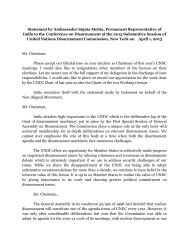
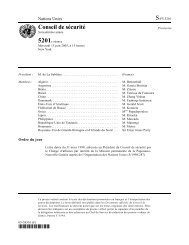
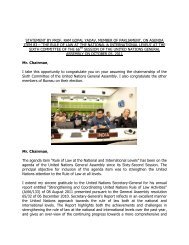
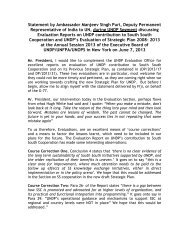
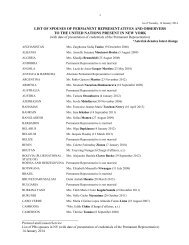
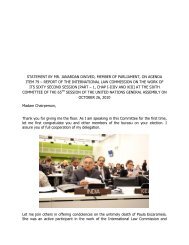
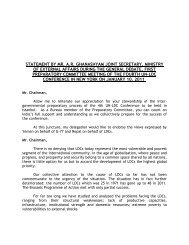
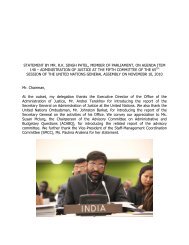

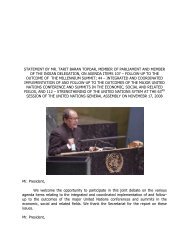
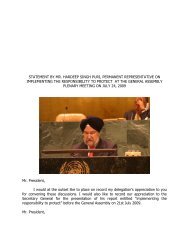
![1 statement by dr.[mrs] kakoli ghosh dastidar - Member States Portal](https://img.yumpu.com/27526598/1/190x245/1-statement-by-drmrs-kakoli-ghosh-dastidar-member-states-portal.jpg?quality=85)
